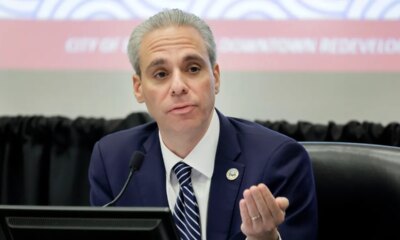Florida
NASA images reveal “ghost forests” in Florida

NASA and U.S. Geological Survey (USGS) satellite images have unveiled a concerning phenomenon in Florida: the emergence of “ghost forests” in the state’s mangrove ecosystems.
These watery graveyards of once-thriving trees are a product of mangrove forests’ increasing vulnerability to intensifying storms and environmental change.
Mangroves are vital to the Florida Everglades. Known for their picturesque, half-submerged roots that create natural tunnels for kayakers, these trees also serve essential ecological and environmental functions.
Mangroves stabilize coastlines, buffer against erosion, store carbon and provide critical shelter for marine life.
Drag slider
compare photos
Florida is estimated to have 600,000 acres of mangrove forests, though their distribution has changed in recent decades mostly as a consequence of human activity, according to the state’s Department of Environmental Protection.
Although mangroves are renowned for their resilience, including their ability to withstand flooding, the recent findings published in the journal Remote Sensing of Environment revealed that stronger and more frequent hurricanes are overwhelming this natural adaptability.
Using decades of Landsat satellite data spanning from 1999 to 2023, researchers identified troubling patterns in mangrove recovery following hurricanes. Unlike previous studies that typically focused on single events, this study paints a broader picture of how these forests respond to storms over time.
The team categorized mangrove conditions into four groups: healthy (unaffected by storms), disturbed (impacted by storms but recovered within a single growing season), recovering (requiring more than one season to recover) and declining (failing to recover and entering long-term decline).
The aftermath of recent hurricanes revealed a sharp rise in the number of declining mangroves. These forests, unable to recover, often transition into “ghost forests,” where dead trees haunt the once bustling coastline.
“Our monitoring has shown a significant increase in the area of mangroves that have lost their natural recovery capacity following recent hurricanes, such as Irma in 2017 and Ian in 2022,” Zhe Zhu, a co-author of the study and a former member of the USGS–NASA Landsat science team said in a statement.
The Landsat-based maps from the study showed clear contrasts between mangrove recovery after hurricanes Wilma (2005) and Irma (2017) in the southern Everglades National Park bordering the Gulf of Mexico.
Lauren Dauphin, using data from Yang, Xiucheng, et al. 2024/NASA Earth Observatory
While most mangroves recovered naturally after Wilma, a significant portion of mangroves impacted by Irma entered a long-term decline, turning into ghost forests.
“Comparing post-hurricane conditions in Florida revealed that the increased frequency and severity of disturbances are challenging mangrove resilience, potentially diminishing their ability to recover and sustain ecosystem functions,” the researchers wrote in the study.
A key innovation of this study was the use of a machine-learning algorithm to analyze satellite data, enabling continuous and detailed tracking of mangrove conditions. This approach provides an early warning system, helping land managers identify areas at risk before losses become irreversible.
“Our research aims to provide an early warning system for mangrove decline, helping to identify areas at risk before irreversible loss occurs,” Zhu said.
The researchers plan to refine their algorithm to better differentiate between the drivers of mangrove change, such as extreme weather, rising sea levels or human activity. They also aim to expand the study to monitor mangroves globally.
“By identifying whether changes are driven by extreme weather events, rising sea levels, or human activities, we can provide more targeted insights for conservation and management strategies in a rapidly changing environment,” Zhu said.
Do you have a tip on a science story that Newsweek should be covering? Do you have a question about comets? Let us know via science@newsweek.com.
Reference
Yang, X., Zhu, Z., Kroeger, K. D., Qiu, S., Covington, S., Conrad, J. R., & Zhu, Z. (2024). Tracking mangrove condition changes using dense Landsat time series. Remote Sensing of Environment, 315, 114461. https://doi.org/10.1016/j.rse.2024.114461

Florida
Photos show Trump Christmas 2025 with Melania at Mar-a-Lago in Florida
Trump’s Mar-a-Lago Years: Palm Beach history, headlines, and legacy
Discover Trump’s transformative legacy at Mar-a-Lago in Palm Beach through rare photos and behind-the-scenes stories in this collector’s edition book.
President Donald Trump and his wife, First Lady Melania, are spending Christmas at his Mar-a-Lago estate in Palm Beach, Florida.
The Trumps spent Christmas Eve on calls with children and military service members.
According to a social media post, Trump and the first lady attended a Christmas Eve dinner in one of Mar-a-Lago’s luxurious ballrooms.
Trump also extended Christmas wishes in a post on TruthSocial, including to what he called the “Radical Left Scum.”
“Merry Christmas to all, including the Radical Left Scum that is doing everything possible to destroy our Country, but are failing badly,” the post reads in part.
See photos: President Trump, Melania spend Christmas 2025 at Mar-a-Lago
Contributing: Antonio Fins, The Palm Beach Post
Florida
‘The naughty list:’ Wrong tag leads to arrest of wanted Central Florida man

VOLUSIA COUNTY, Fla. – A wanted Central Florida man was caught after deputies noticed that his car had a wrong tag, according to the Volusia Sheriff’s Office.
In a release on Wednesday, deputies said they initially spotted a car with a tag that didn’t belong on it.
“A little research showed (the driver) had an open warrant for occupied burglary,” the release reads. “He tried to accelerate and ram his way out of trouble, but that only led to more charges.”
Body-camera footage shows deputies confront and ultimately catch the driver, identified as 33-year-old Dillon Cottrell.
According to the sheriff’s office, deputies also recovered a trafficking amount of fentanyl and other drugs.
Now, Cottrell faces charges of burglary, criminal mischief, fleeing law enforcement, trafficking in fentanyl, possession of a controlled substance without a prescription, aggravated battery on a law enforcement officer, resisting arrest, and obstructing law enforcement.
He is held without bond. His passenger, Kelli Jo Hands, was also arrested, deputies added.
“Both are still in jail and most likely spending Christmas there,” the release concludes.
Copyright 2025 by WKMG ClickOrlando – All rights reserved.
Florida
Grand Rapids police chief is candidate for Florida job: Eric Winstrom faced early trial

GRAND RAPIDS, MI – Just weeks into his new job, Grand Rapids Police Chief Eric Winstrom – sharing a small apartment with his wife and two children – was told that an officer was just involved in a shooting.
A former commander for Chicago Police Department, Winstrom had dealt with many shootings involving police.
Officer Christopher Schurr shot and killed Black motorist Patrick Lyoya after a Feb. 4, 2022, traffic stop. Schurr, a white officer, shot Lyoya in the back of the head.
Winstrom, who was named this week one of three finalists for police chief in Pensacola, Florida, recalled the tragedy in Grand Rapids in an MLive video 13 months after the killing.
He became chief in Grand Rapids on March 7, 2022.
He described the shooting as “just like a slap across the face and a wake-up call because I had been involved in so many of these difficult situations in Chicago. So I was like, ‘Oh, OK, I guess we’re doing this here so quick’ and it was I would say a progression of sadness.”
He met with Lyoya’s family in his office, “crying literally with them.” He knew that Schurr, who was ultimately acquitted by a Kent County jury of second-degree murder, and his family were devastated, too.
Winstrom fired Schurr after charges were filed.
He knew that his officers had strong feelings, with many supporting Schurr, who said he acted in self-defense when Lyoya gained control of his Taser.
Winstrom, who often responds to serious crime scenes, said: “I’ll say that this department – I’m sure everybody’s got their opinions – but from what I’ve seen they’ve handled it professionally … have not let it impact job performance at all which was something that I was really afraid of.”
That has happened in other U.S. cities after controversial police shootings. Lyoya’s supporters held many protests, particularly when the officer was on trial.
Windstrom said that calls to defund police can lead to a ‘mass exodus’ of officers, which data shows results in increasing violence in minority neighborhoods.
He said that “officers in Grand Rapids, whether they agree with my decision to fire Christopher or not, come to work every day. They just do a phenomenal, professional job. I’m really proud of them.”
Winstrom is a finalist for the Pensacola job with Brian Dugan, a former Tampa police chief, and Erik Goss, the acting deputy chief in Pensacola, the Pensacola News Journal reported.
The selection process will occur Jan. 12 to 14.
Winstrom declined an MLive request for comment on Wednesday, Dec. 24, but issued a statement the previous day.
He asked for patience while he considered what is best for him and his family. He said he will be “engaged here as ever” during the process and “I remain fully committed to ensuring the City of Grand Rapids is a community where people feel safe and are safe at all times.“
City Manager Mark Washington appointed Winstrom nearly four years ago knowing “that he was a highly qualified, top-tier professional in the field of public safety. While he hadn’t served as a Chief of Police, his potential was evident.”
Washington added: “Given the significant progress he has led within the Grand Rapids Police Department – specifically in advancing constitutional policing, enhancing transparency, and centering the department’s commitment to serve all residents – it is certainly not surprising that other communities would seek out his leadership and expertise.”
-

 Maine1 week ago
Maine1 week agoElementary-aged student killed in school bus crash in southern Maine
-

 Massachusetts1 week ago
Massachusetts1 week agoMIT professor Nuno F.G. Loureiro, a 47-year-old physicist and fusion scientist, shot and killed in his home in Brookline, Mass. | Fortune
-

 New Mexico1 week ago
New Mexico1 week agoFamily clarifies why they believe missing New Mexico man is dead
-

 Culture1 week ago
Culture1 week agoTry This Quiz and See How Much You Know About Jane Austen
-

 World6 days ago
World6 days agoPutin says Russia won’t launch new attacks on other countries ‘if you treat us with respect’
-

 Maine1 week ago
Maine1 week agoFamily in Maine host food pantry for deer | Hand Off
-

 Minneapolis, MN1 week ago
Minneapolis, MN1 week agoMinneapolis man is third convicted in Coon Rapids triple murder
-

 Culture1 week ago
Culture1 week agoRevisiting Jane Austen’s Cultural Impact for Her 250th Birthday























